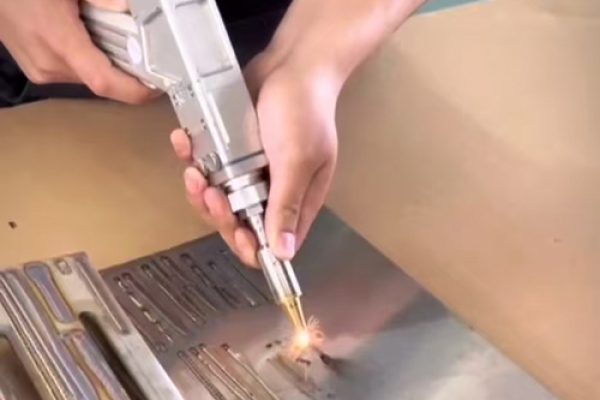Handheld laser welding machines have become increasingly popular in industries such as metal fabrication, automotive repair, and precision manufacturing. They offer speed, flexibility, and high-quality welds. However, like any advanced technology, improper settings or usage can sometimes lead to unsatisfactory results.
One of the most frequently reported problems is when the weld seam shows discontinuities (broken lines) and excessive spatter. These issues not only affect the appearance of the weld but also compromise its strength and durability. In this guide, we’ll explore the common causes and solutions so that you can optimize your machine’s performance and achieve clean, strong welds every time.
Common Problem: Poor Welding Effect with Breakpoints and Heavy Spatter
When operators notice welding discontinuities, weak penetration, or too much laser spatter, it usually indicates that the machine settings are not optimized. This is rarely a sign of machine failure—in most cases, a few quick adjustments can restore excellent welding quality.
Below are the two most common causes and their solutions.
1. Laser Power Adjustment Issues
Cause:
- The laser power is too low, which means the heat input is insufficient to fully penetrate the material.
- Alternatively, the focus position may not be aligned properly, leading to uneven distribution of energy.
- Both cases result in weld seams with breakpoints, weak bonding, or visible pores.
✅ Solution:
- Increase the laser power gradually until the weld seam is continuous and smooth.
- Adjust the focal position to ensure the laser is concentrated on the joint surface. A focus that is too high or too low reduces energy density and causes defects.
- Check for beam alignment and clean the protective lens if necessary, as contamination can weaken the laser’s power output.
By optimizing the power settings and focal alignment, you will achieve stronger penetration and eliminate the broken-line effect in your welds.
2. Oscillation Length and Frequency Problems
Cause:
Many handheld laser welding machines use a wobble welding head to improve seam width and welding stability. However:
- If the oscillation length is too short or the frequency is too high, the weld seam becomes narrow and unstable.
- If the settings are mismatched to the material thickness, it can cause irregular spatter and discontinuities.
✅ Solution:
- Adjust the oscillation length to a more suitable range for the material thickness. Thicker plates generally require larger oscillation.
- Lower the oscillation frequency if you notice excessive spatter. This will stabilize the molten pool and produce a smoother seam.
- Perform a trial weld on a sample piece before processing the final workpiece to confirm that the settings produce the desired effect.
Properly tuned oscillation ensures a stable weld pool, reduces spatter, and gives you a neat, consistent seam.
Additional Tips for Better Welding Results
While laser power and oscillation settings are the most common culprits, consider the following best practices as well:
- Gas shielding: Ensure proper use of nitrogen or argon shielding gas. Inadequate shielding can cause oxidation and spatter.
- Material preparation: Clean the surface before welding. Rust, oil, or paint can interfere with the beam and cause instability.
- Consistent hand movement: A steady welding motion prevents uneven heat distribution and reduces visible spatter.
- Protective lens care: Replace or clean protective windows regularly to maintain consistent beam quality.
Why Proper Settings Matter
Handheld laser welding machines are designed to produce high-quality, spatter-free welds. If you encounter issues like discontinuities or large amounts of spatter, don’t rush to assume the machine is defective. Instead, remember that laser power, focal position, and wobble parameters directly determine the welding outcome.
By fine-tuning these settings, you can:
- Improve weld seam consistency
- Reduce or eliminate spatter
- Enhance bonding strength
- Minimize post-processing work
Handheld Laser Welding Machine – FAQ
Q1: Why does my handheld laser welding machine produce weld seams with gaps or breakpoints?
A1: This usually happens when the laser power is too low or the focus position is misaligned. Increase the power gradually, adjust the focal point to the correct position, and check if the protective lens is clean. These steps help achieve continuous, strong weld seams.
Q2: How can I reduce spatter during handheld laser welding?
A2: Excessive spatter is often caused by incorrect oscillation length or frequency settings. Adjust the wobble length according to material thickness and lower the frequency if the weld pool looks unstable. Proper parameter tuning will stabilize the melt pool and reduce spatter.
Q3: What else can I do to improve welding quality?
A3: Make sure to use proper shielding gas (nitrogen or argon), keep the workpiece surface clean (remove rust, oil, or paint), and maintain a steady welding motion. Regularly check and replace protective lenses to keep laser output consistent.
In Summerize
The handheld laser welding machine is one of the most powerful tools in modern metalworking, offering unmatched precision and efficiency. But like any advanced equipment, its performance depends on the correct parameter settings.
If your welds are showing breakpoints or heavy spatter, start by checking:
- Laser power and focus position
- Oscillation length and frequency
With these adjustments, you’ll quickly restore clean, stable, and high-quality welds.
For more detailed guidance, training, or troubleshooting support, feel free to contact our team—we’re here to help you get the best results from your handheld laser welding machine.

